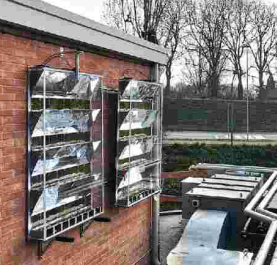Integrating PV with heat energy trapping coatings into building facades

Developed by an association of the research partners the Hybrid Solar PVT Panel was developed in the first phase of the project and trialled in the prototype installation in University of Ferrara. The panels are now installed in both of the full scale demonstration sites in Drummin, Co. Mayo, Ireland, and The University of Ferrara, Italy The Hybrid PVT panel consists of:

Light Downshifting Layer (LDS) An array of newly developed PV cells using LDS to increase solar energy collection and transference to electrical energy. The LDS uses specially formulated dyes which refract more energy from the sun than traditional cell coatings.
Luminescent Downshifting (LDS) is a method of improving the PV cells’ solar responsivity through the inclusion of a layer on the cells’ surface that re-emits the short wavelength light at longer wavelengths where the solar cells’ have higher responsivity. It converts photons of high energy (short wavelength) to photons of lower energy (hence downshifting energy) that the photovoltaic materials can more easily absorb and process. Ideally, the dye used within the layer should have a wide absorption band in the range of wavelengths that need to be enhanced and a narrow emission peak in the region where the PV cell already performs very efficiently (500-900nm).
Extensive research on this phenomenon was been completed by IDEAS team members in Trinity College Dublin and this shows that the inclusion of the LDS layer can greatly enhance PV cells’ performance providing the correct dye has been selected.
Phase Change Material (PCM) enhanced Heat Collection PCM heat sink modules were configured to the PV cell array to increase the cells’ efficiency by reducing overheating, while at the same diverting excess heat to a heat storage which combines with the Heat Pump components below to maximise the rate of energy collection.


Compound Parabolic Concentrators (CPCs) These are site specific arrays of reflective material which reflects the rays of the sun to maximise the exposure of the PV array to the sun’s energy. Their design means that they can be installed on the façade of the building and still produce adequate thermal and electrical power. The CPC is part of the technologies applicability to deployments where space is limited: in built up areas or on medium and high-rise urban buildings where the roof area to building volume area ratio makes building renewable energy self-sufficiency problematic.
The CPC configuration varies according to the latitude of the installation – it was specifically designed for the low-sum of North Mayo (53 degrees N) and also separately for the latitudes of the other demonstration installation in Ferrara, Italy (44 degrees Nth).